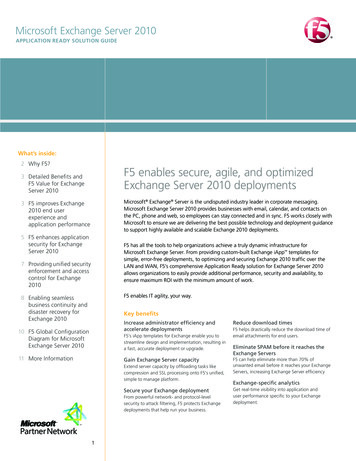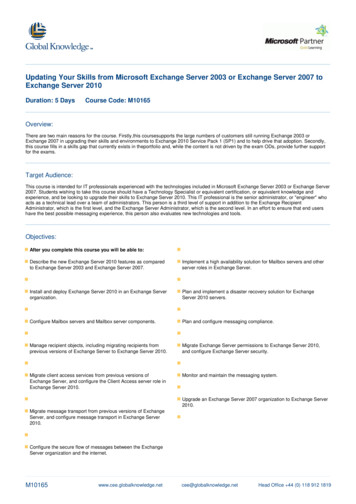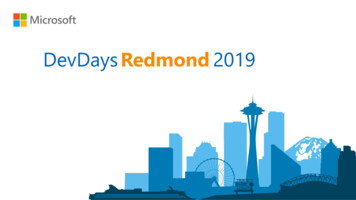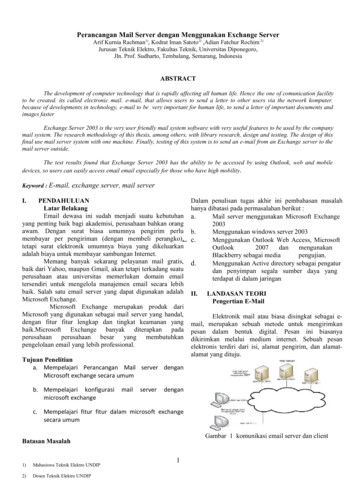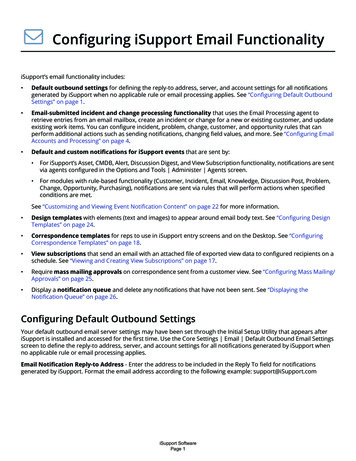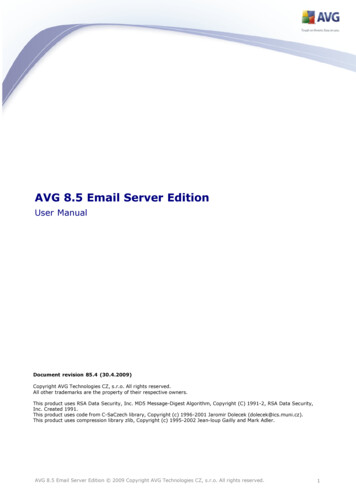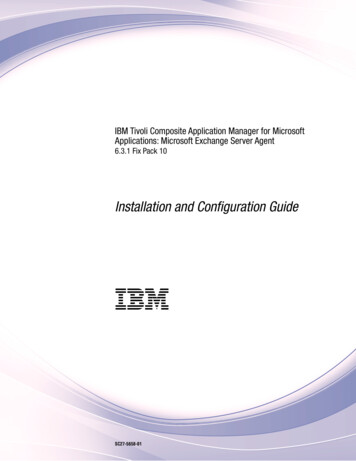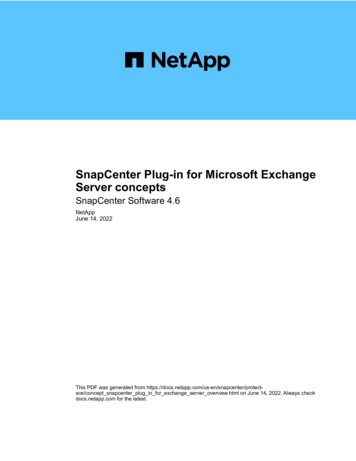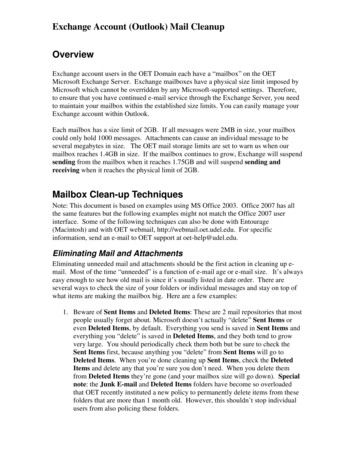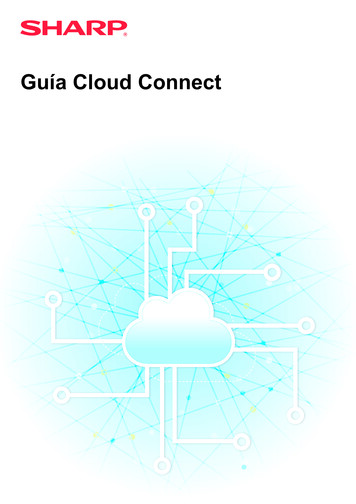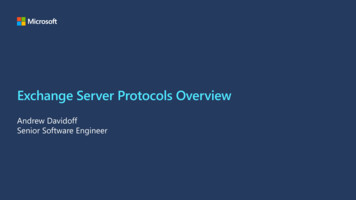
Transcription
Exchange Server Protocols OverviewAndrew DavidoffSenior Software Engineer
Agenda Exchange Protocols scope Exchange Protocols details Choice of protocols to use Resources
Exchange Protocols: Scope
Glossary MAPI - Mail API, since 1990th. Originally library used by Outlookfor Windows Desktop.RPC - Remote Procedure CallOn-Prem Exchange Server - Physical Exchange Server in your ownserver topologyExchange Online - Exchange Servers in the Cloud (Microsoft 365)Hybrid Exchange - Configuration where on-prem topology andExchange Online tenant are connected
ExchangeOnlineRestGraphMicrosoft365ServicesCloud (M365)Dev AppsEWSExchangeOn PremMAPIEmail ClientsEAS
Client communication with Exchange e
There is more to Exchange than emailCalendarsRecurring meetings, cross time zone schedulingTasksOne-time or recurringContactsMultiple Contacts Folders, Suggested ContactsRemindersFor Calendars, Tasks, EmailsNotificationsServer notifies Client that mailbox changed (new mail, etc.)Availability – both attendees and conference roomsTracking Due Date and AssignmentAddress book for mobile devicesPush or Pull
There is even more to Exchange than emailRulesServer Side and Client SideOut of OfficeInternal and External recipients can get different OOF messagesMail TipsShow user that recipient is Out of OfficeComplianceLegal Search (eDiscovery)ArchivingSeparate Archive for old emails, accessible by clientAnd so on.Applied on messages on arrival, even when client is not connectedTime restrictionsWarning that mail includes very large DL, etc.Legal HoldRetention policies set per folder
Exchange Protocols: Details
Overview Document: MS-OXPROTODefines protocol families Scenario-Based How protocols work togetherWalkthroughs andexamples Display an e-mailSend an attachmentCreate an appointment and other scenarios
Protocol Families ROP Protocols Originally RPC transport HTTPS transport introduced inExchange 2013 NSPI is used for Address Book access Exchange Web Services (EWS) ActiveSync (EAS) Other protocol groups Autodiscover Content Conversion Standards Support
Exchange Protocols: DetailsROP Protocols
History of terminology – what is “ROP”?Initial name: RPC protocols Remote Operations (ROPs) over RPC connectionRPC is just a channel to exchange binary blobs between client and serverThis binary blob can be transmitted by other underlying protocols RPC over TCP or RPC over HTTPS (MS-OXCRPC)Pure HTTPS (MS-OXCMAPIHTTP)MAPIHTTP is RPC replacement (Exchange Server 2013) The same binary blob is now transmitted over HTTP, bypassing RPCSince it’s not RPC anymore, we now call them ROP Protocols In many places it is still called “Exchange RPC protocols”, sometimes MAPI
ROP Protocols DetailsTransport layers: RPC/TCP, RPC/HTTPS or pure HTTPS Low-level access to Exchange Server Storage Optimized to minimize traffic on the wireVery complex parsingUsed by MAPI Major channel for Outlook for Windows Desktop communication with Exchange ServerOriginally implemented in Exchange 4.0 (first release of Exchange) Extended and re-architected several times
ROP Protocols DocumentationROPs protocols define both Server and Client behaviors Client behaviors are very complex Wrapped in MAPI implementation on Outlook for Windows DesktopClient performs logic to maintain complex items: Messages, Folders, Calendar, Contacts,Tasks, etc Document Naming: [MS-OXO*] and [MS-OXC*] Over 40 Protocols, 3000 pages
Example of complexity in ROP opIDROP DataBinary BlobROP2RopID HSOT TableROP DataNote: No ROP Data size or end marker.Every ROP Data in the blob must be parsed.Every RopID has different ROP Data structure.Number of documented RopIDs: 130
Where to start: ROP Protocols
ROP Protocols SummaryNot recommended for new applications due to complexity Modern Exchange Server has good alternatives Exchange Web Services for On-Prem ServerMicrosoft Graph for Exchange Online
Exchange Protocols: DetailsExchange Web Services (EWS)
EWS Protocols: DetailsAlternative to ROP protocols Higher level of abstraction compared with ROP protocols EWS implements messages, attachments, calendar events, contacts on server sideOutlook for Windows Desktop uses subset of EWS protocols Unified Messaging, MailTips, Availability, OOF, Office Apps, Room List, Archive, Mailbox Policies, Calendar Sharing,Site Mailboxes, etc.Intuitive/readable XML (easier troubleshooting)Transport: SOAP over HTTP(S)
EWS Protocols: DocumentationCode in any language/platform that supports HTTP/SOAP calls SDKs are available as wellDocument Naming: [MS-OXW*] 43 Protocols, 2000 pagesFirst implementation: Exchange Server 2007 New on-prem features tend to be implemented in EWS
Where to start: EWSNot hierarchical Start withMS-OXWSCORE
EWS SDKsExchange Web Services (EWS) Managed API WebServices/ https://github.com/OfficeDev/ews-managed-api ged-api-ews-and-web-services-in-exchange
EWS SummaryRecommended protocol for on-prem Exchange Server applications Legacy authentication only No OAUTHGRAPH/REST APIs is better alternative for Exchange Online andHybrid Exchange Server Modern authenticationSeamless integration with other services (SharePoint,OneDrive, Azure Active Directory, etc.)Future updates will happen in Microsoft Graph APIs
Exchange Protocols: DetailsExchange Active Sync (EAS)
Exchange ActiveSync: Protocols DetailsLightweight synchronization protocol for Exchange Server Optimized to work on high-latency and low-bandwidth networksDesigned to minimize device power usageHigh level of abstraction, similar to EWS in complexity Provides access to email, calendar, contacts, tasks, documents, etc.Transport Layer: WBXML over HTTPS Industry standard Several non-Exchange Server implementationsWide range of clients – iOS, Android, Windows, etc.
Exchange ActiveSync: Protocols DocumentationDocument Naming: [MS-AS*] 15 Protocols; 900 pagesFirst Implementation: Exchange Server 2003
SCALMS-ASDOCMS-ASCNTCMS-ASPROVWhere to start: Exchange ActiveSync
Typical Usage of Exchange ActiveSyncMobile Applications Tablets and lightweight desktop applications Additional considerations Allows for low-bandwidth and high-latency data (Internet) connections while scalingreasonably on high-speed connections.Not feature parity with Exchange ROPs and Web Service (EWS) protocolsLicensing requirementsMicrosoft Graph APIs should be considered as betteralternative for Exchange online
Choice of Protocols to Use
On-Premises choiceEWS is recommended for new applications ROPs protocols are very complex EAS has special purpose Hybrid mode brings on-line richness to on-prem implementations
Exchange Online has more If you develop for Exchange Online, consider Microsoft Graph APIs //aka.ms/30DaysMSGraph
Resources
Exchange Protocol Test ToolsProtocol Test Suites Protocol families: EAS, EWS, and ROPs (RPC/MAPIHTTP)Fiddler Inspectors: Protocol families: ROPs (MAPIHTTP)Additional associated protocols
Exchange Protocol ResourcesAll Exchange protocol s/exchange server protocolsFiddler inspectors for Office and Exchange ctors-for-FiddlerProtocol Test tesOffice Interoperability 8835Help with Open Specifications:mailto:dochelp@microsoft.com
Copyright Microsoft Corporation. All rights reserved.
Glossary MAPI - Mail API, since 1990th. Originally library used by Outlook for Windows Desktop. RPC - Remote Procedure Call On-Prem Exchange Server - Physical Exchange Server in your own server topology Exchange Online - Exchange Servers in the Cloud (Microsoft 365) Hybrid Exchange - Configuration where on-prem topology and Exchange Online tenant are connected

